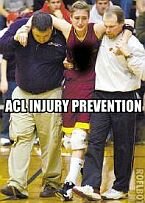Feet (Plantar Fasciitis)
Plantar fasciitis, a common overuse injury, describes pain in the region of the heel and sole of the foot. It is characterized by pain that is usually more severe when a person first arises. Precipitating factor include poor foot mechanics, training errors, muscle weakness and inflexibility. It accounts for about 10% of running injuries. Treatment involves decreasing inflammation, correcting foot mechanics and training errors and rehabilitative exercise.
The word fascia refers to a Saran wrap type tissue which surrounds a muscle. The plantar fascia runs from the heel bone (calcaneus) to the base of the toes. It helps to maintain the inside (medial) arch of the foot. It also acts as part of the shock-absorbing mechanism of the foot and stabilizes the foot during toe-off. During running, the force generated with each heel strike is two to four times body weight and occurs 800 to 2000 times per mile. Overuse can cause overload at the insertion of the plantar fascia at the calcaneus. This repetitive microtrauma initially causes an acute inflammation. Over time, it can become a chronic condition in which the tissue becomes weaker and less elastic.
The characteristic history of plantar fasciitis is marked by the often- surprising onset of sharp pain in the sole of the foot, usually close to the calcaneus. The pain is usually most severe with the first few steps in the morning and eases during the day. If it progresses, the pain may interfere with any weight-bearing activity. Pain caused by pressure in the area of the heal confers the diagnosis. If the condition is chronic a spur often forms at the anterior (front) edge of the calcaneus. The spur is the RESULT of the pulling of the tissue on the calcaneus. Similar conditions which must be excluded are tarsal tunnel syndrome (an entrapment of the nerve at the inside of the ankle), partial rupture of the plantar fascia, a more severe tearing of the fascia, and stress fracture of the calcaneus.
Causes of plantar fasciitis include:
- Training errors- sudden increase in mileage or excessive mileage, change to running on a hard surface, hill running.
- Poor fitting shoes
- Poor biomechanics- over pronation, high foot arch, leg length discrepancy, tight achilles tendon
- Systemic disorders- gout and different arthritis conditions.
Treatment of plantar fasciitis is multi-faceted. First, complete rest or relative rest must be considered. If there is constant pain with any weight-bearing exercise, rest from exercise for about one week should be considered. If weight-bearing activity causes some pain, then a non-weight-bearing activity like water running, bike, slide, cross-country ski machine may be used. Ice must be used on the area. Physical therapy modalities like ultrasound or ultrasound combined with electrical stimulation can be used to speed healing.
Adhesions form in the sole of the foot in the plantar fasia, plantar aponeurosis and the intrinsic muscles. Other areas like the Achilles Tendon, muscles of the calf and front of the leg must be checked as well for adhesions. This scar tissue must be broken up to allow the tissue to heal properly. When the tissue tears, the first response in the body is an inflammation that may or may not cause significant swelling. The texture of the tissue changes and after the initial inflammation the tissue feels taut like a guitar string and bumpy like gravel. Have you ever kneaded bread dough or pottery clay and tried to get the lumps out to make it smooth? This is like what treating the injured tissue feels like. This "adhesion" or scar tissue must be broken up or kneaded away.
Two techniques that break up these adhesions in the muscles are called Active Release Techniques® and Graston Technique.
This cannot be accomplished with anti-inflammatory medicines like ibuprofen (Advil, Motrin, Nuprin), naproxen (Aleve), Celebrex or Vioxx. These medications can help with the initial inflammation and pain, but they can disrupt and prevent proper healing of the muscle tissue. Also significant are the side effects, especially gastro-intestinal bleeding which kills thousands of people each year.
Strengthening, which includes toe flexion exercises (squeeze toes 50 times, pick up marbles with toes, crumple newspaper with toes, fan phonebook pages with toes) must be done. Stretching of both the gastrocnemius and soleus muscles (calf stretch with back leg straight and back leg bent) is important as well. You may want to try an interesting product called the "Strassburg Sock". The sock is designed to keep the fascia and muscles of the foot in a mildly stretched position throughout the night. This prevents the tissue from shortening overnight. Wear it until the pain abates. If these measures do not work, orthotics may be useful.
Correction of training errors is essential. This is where a good coach comes in handy. Finally, wearing properly fitting shoes is a must. Go to a store where they are knowledgeable about the different models of shoes. Unfortunately, shoe manufacturers (dress, casual and athletic) frequently change their shoes year to year so if you find a pair that fits, buy two!
See a very comprehensive article about Plantar Fasciitis for more information.
|
The Ultimate Nutritional Lie Detector Test LEARN MORE 
|
Kettlebell Rehab

Click Here
To See How Kettlebells will transform your body!
Vortex Rehab

Click Here
To See How This
Revolutionary Machine
Can Help You!
Partner / Support

Loans up to 3 months - fast cash advances for up to 90 days and up to $5,000!


















